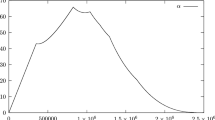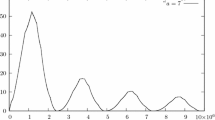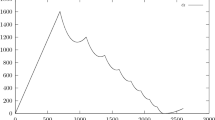Abstract
We prove that the “quadratic irrational rotation” exhibits a central limit theorem. More precisely, let α be an arbitrary real root of a quadratic equation with integer coefficients; say, \(\alpha = \sqrt 2\) . Given any rational number 0 < x < 1 (say, x = 1/2) and any positive integer n, we count the number of elements of the sequence α, 2α, 3α, ..., nα modulo 1 that fall into the subinterval [0, x]. We prove that this counting number satisfies a central limit theorem in the following sense. First, we subtract the “expected number” nx from the counting number, and study the typical fluctuation of this difference as n runs in a long interval 1 ≤ n ≤ N. Depending on α and x, we may need an extra additive correction of constant times logarithm of N; furthermore, what we always need is a multiplicative correction: division by (another) constant times square root of logarithm of N. If N is large, the distribution of this renormalized counting number, as n runs in 1 ≤ n ≤ N, is very close to the standard normal distribution (bell shaped curve), and the corresponding error term tends to zero as N tends to infinity. This is the main result of the paper (see Theorem 1.1).
Similar content being viewed by others
References
J. Beck, Inevitable Randomness in Discrete Mathematics, University Lecture Series, Vol. 49, Amer. Math. Soc., 2009.
P. D. T. A. Elliott, Probabilistic number theory, Vol. 1 and 2, Springer, 1979–80.
G. H. Hardy and J. Littlewood, The lattice-points of a right-angled triangle. I, Proc. London Math. Soc., 3 (1920), 15–36.
G. H. Hardy and J. Littlewood, The lattice-points of a right-angled triangle. II, Abh. Math. Sem. Hamburg, 1 (1922), 212–249.
G. H. Hardy and E. M. Wright, An introduction to the theory of numbers, 5th edition, Clarendon Press, Oxford, 1979.
M. Kac, Probability methods in some problems of analysis and number theory, Bull. Amer. Math. Soc., 55 (1949), 641–665.
Kesten, H., Uniform distribution mod 1, Ann. Math., 71 (1960), 445–471; Part II, Acta Arithm., 7 (1961), 355–360.
D. E. Knuth, The art of computer programming, Vol. 3, Addison-Wesley, 1998.
S. Lang, Introduction to Diophantine Approximations, Addison-Wesley, 1966.
A. Ostrowski, Bemerkungen zur Theorie der Diophantischen Approximationen. I, Abh. Hamburg Sem., 1 (1922), 77–99.
T. Shintani, On evaluation of zeta functions of totally real algebraic number fields at non-positive integers, J. Fac. Sci. Univ. Tokyo, 23 (1976), 393–417.
Vera T. Sós, On the discrepancy of the sequence }nα}, Colloq. Math. Soc. János Bolyai13, 1974, 359–367.
S. Wolfram, A new kind of science, Wolfram Media, 2002.
D. B. Zagier, On the values at negative integers of the zeta-function of a real quadratic field, Einseignement Math. (2), 22 (1976), 55–95.
D. B. Zagier, Valeurs des functions zeta des corps quadratiques reels aux entiers negatifs, Journées Arithmétiques de Caen, Asterisque, 41–42 (1977), 135–151.
Author information
Authors and Affiliations
Corresponding author
Additional information
Communicated by Attila Pethő
Rights and permissions
About this article
Cite this article
Beck, J. Randomness of the square root of 2 and the giant leap, part 2. Period Math Hung 62, 127–246 (2011). https://doi.org/10.1007/s10998-011-6127-3
Received:
Accepted:
Published:
Issue Date:
DOI: https://doi.org/10.1007/s10998-011-6127-3




